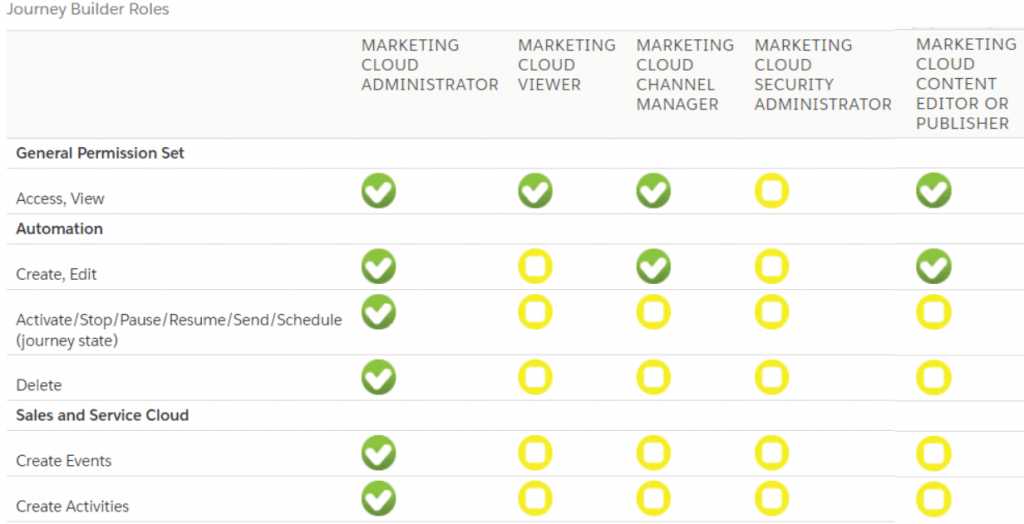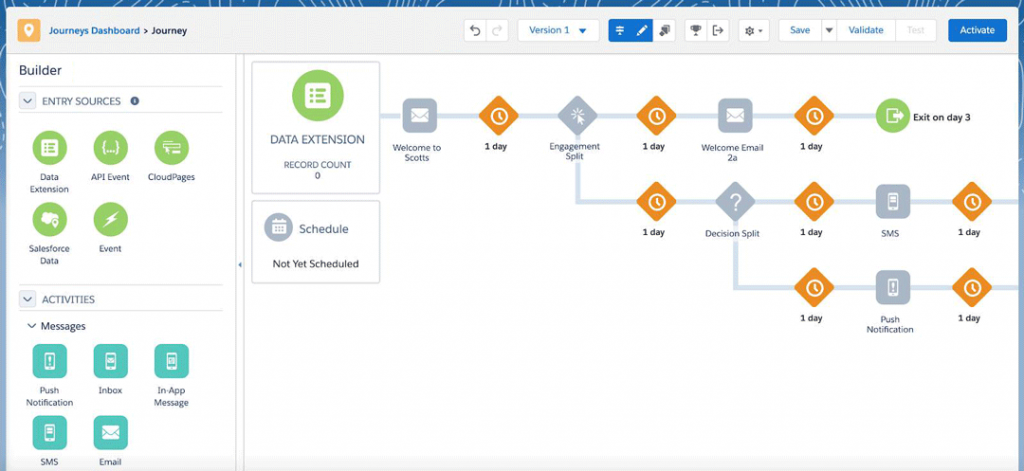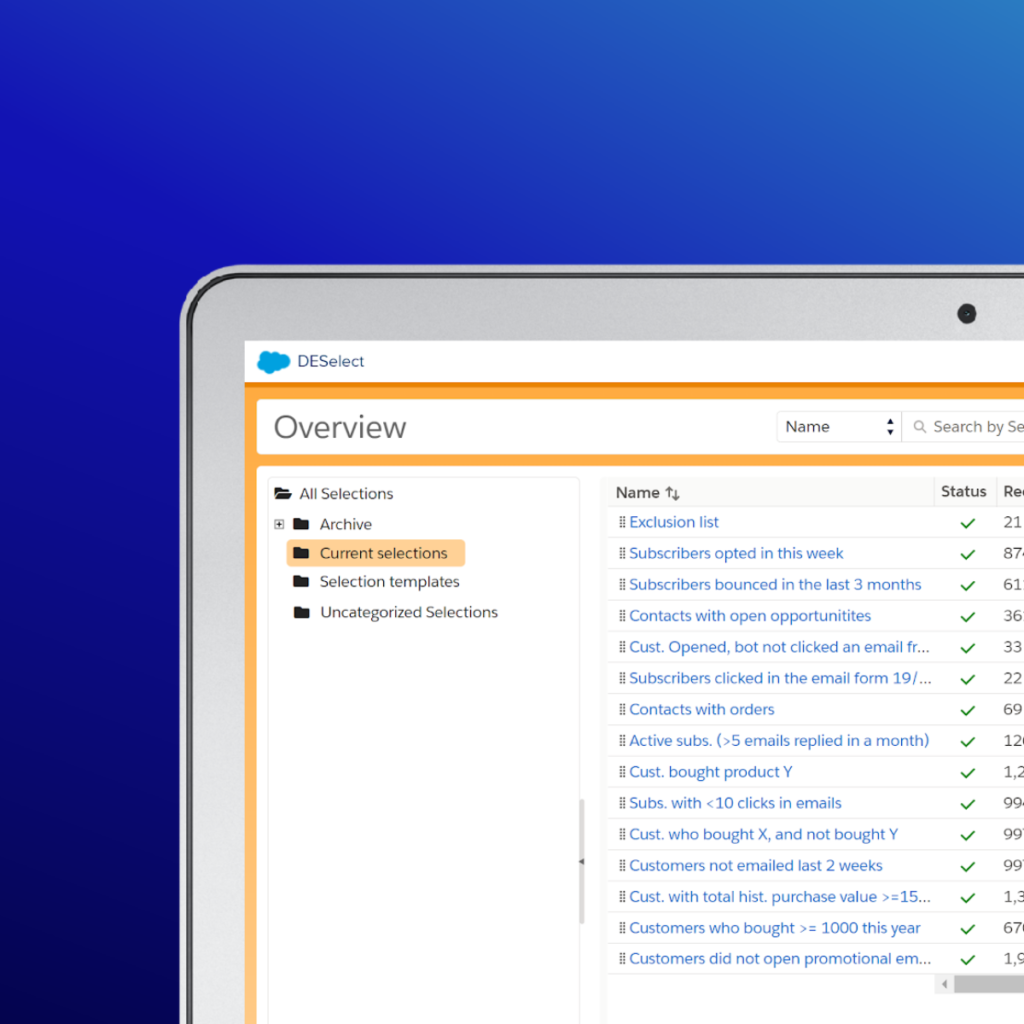Journey Builder in Salesforce Marketing Cloud
Salesforce Journey Builder is an intuitive marketing tool that allows you to interact with your customers on a 1-to-1 customer experience platform across multiple channels.
Learn how to make every interaction with your customers as consistent and unified as possible. Connect every communication across email, mobile, advertising, and the web for a seamless customer experience.
This guide covers everything you need to know about this innovative program and its activities.
What is Journey Builder?
This feature in the Salesforce Marketing Cloud makes it easy for you to design customer journeys by giving you a straightforward user interface to build multiple individualized interactions all within one feature in Salesforce Marketing Cloud.
With this tool, you can set goals based on behaviors, so your marketing team knows how each one of their campaigns contributes towards the bigger goal.
With Journey Builder, SFMC can provide you with the ability to integrate with Sales Cloud and Service Cloud. As a result, you can keep on top of any customer responses while avoiding duplication in efforts.
How to Use and Implement Journey Builder Salesforce Within Your Organization
This tool gives your customers a way to find what they want easily and quickly while giving you the data you need for better insights on creating content that resonates with all ages and demographics of your customer base.
This software makes it easy to automate campaigns. Your campaign can start by converting leads to another marketing channel based on their behavior.
It is an easy-to-use visual flow tool where marketers can design their own automated omnichannel customer journeys in campaigns for:
- SMS Push notifications
- Targeted ads
You set your activities and configure them with the program’s analytics engine. It will run responsive automatic campaigns while evaluating customer interactions continuously, so you know when they are ready for more contact from other channels, like phone or text messages.
It turns your customer’s experience of using your product into an engaging journey. It helps increase loyalty and ROI by providing personalized interactions with customers while simplifying developing these customized experiences.
As a supplement, we’ve built a useful solution; the DESelect Search Chrome Extension, making it easier for users to quickly search for the following elements in their marketing cloud.
- Data Extensions
- User Sends
- Email Templates
- Content
- Automations
- Query Activities
- Filter Definitions
- All Content Builder objects
Install DESelect Search for SFMC
Add DESelect Search to Chrome and boost your productivity in SFMC for Free

Journey Builder for SFMC Users
Getting started with Builder is easy. All you need to do is speak to your account manager about adding the module to your subscription–it’s an additional fee, but most marketers find it to be a smart investment.
This application defines the roles and responsibilities of users. For example, who can edit a journey? And who can only view it?
Here’s an overview of the SFMC user roles and permissions:
 Note: green means permissions granted. Yellow means permission not explicitly granted or denied.
Note: green means permissions granted. Yellow means permission not explicitly granted or denied.
Automation Studio Vs. Journey Builder: The Key Differences
Salesforce Marketing Cloud’s Automation Studio and Journey Builder both serve different purposes. The purpose of Automation Studio is to perform ETL, whereas Journey Builders’ goal is to create that 1:1 individualized journey for your prospect communications. Salesforce Marketing Cloud’s Automation Studio will allow you to send emails automatically. It also allows for simple data and file imports, which is great if that is what your needs are.
What Builds a Journey: 3 Pillars

If you’re looking for a way to engage your customers and provide an unforgettable experience, then Journey Builder in Marketing Cloud is the perfect solution. From multi-step adventures where they choose their own path through or send journeys where it’s as simple as pressing “send,” there is something here for everyone, no matter what kind of message you want to deliver.
It allows you to create complex customer journeys adaptable to almost any need a marketer can imagine.
A multi-step journey comprises three main pillars. You can add more complexity by adding other parts from the Sales Cloud or Service Cloud. Here are the three pillars:
Entry Source
The data you choose will make an incredible difference in the type of insights and analysis that your journey can produce. For example, uploading an event from APIs to Cloud Pages would be great for understanding when customers are most active on social media or what interests them. It also uses geolocation information for better insights.
There are many possibilities from which you can choose. Remember that the more segmented data source you choose, the better results your journey will get. Segmentation tools allow marketers to build journeys without having to write a single string of code.
Do not use the same entry source data extension to power multiple journeys, as this can lead to incorrect processing of your contacts throughout your journey. This action will also avoid spamming or duplicating contact communication. Instead, make a pre-filtered copy for each.
By pre-filtering your data, you can save time and energy on some of the more tedious aspects that come with building a journey. Choosing an ETL (Extract Transform Load) tool like Automation Studio to perform large-scale segmentation before injection into Journey Builder.
For example, DESelect’s drag-and-drop interface lets users create advanced segments by simply telling them what they are looking for to create segments immediately. This process saves both time and frustration.
Activities
The messages you send to your customers reflect the relationship between them and your company. They show how successful that journey was.
If they’re opening the emails or clicking through from SMS, or text notifications, it’s likely going well. But if there is no response at all–could something be wrong?
Journey Builder can help with this by offering various ways in which people may want to receive information about the next events or product releases.
Test out these different options, then decide on one particular strategy best suited for those who will receive updates via phone number, text messaging.
Flow Control
Now you must decide on the flow of your journey. What are the cadence, quantity, and frequency? How many messages do you want to send out in each episode? Do you want any A/B tests or optimization for a live campaign once it goes public after creation?
To ensure that your audience can experience the same interactive journey, it is essential to learn how to change the rules of the audience in Journey Builder Marketing Cloud. You can use a path optimizer functionality. The way this works is by testing different paths. Then you will send it on as feedback to everyone who has chosen it for themselves.
However, if you delete one of the Decision Splits in your pathway, all subsequent parts will also get deleted. If there are additional steps added to an already running process or project, beware.
Updating won’t work because any existing contacts for that version will remain intact. Instead, copy what’s needed from another site using “copy” so everything gets updated at once. Only new contacts added to the second journey will get the updated journey.
There are many nuances about using and implementing Journey Builder Salesforce. Be prepared to encounter unexpected situations. Stay calm and be ready to change aspects, so you get the most out of building a journey.
Marketing Cloud Journey Builder Best Practices: Things to Consider
This marketing cloud feature is user-friendly, which you can use to expand your marketing campaign reach rapidly. Here are some best practices from our Marketing Cloud experts for getting started on this new platform:
Check Out Journey Builder Templates
This application offers pre-built templates for many of your marketing needs, so you can choose what best fits your audience. A journey is a series of steps or stages to reach an end goal, and there are plenty available on the site.
There is everything from simple newsletters about upcoming events, to emails or invitations to take part in surveys that helps you learn more about your customers.
Organize Your Journeys
Salesforce Journey Builder templates are a great way to organize the complexity of your journey into bite-sized chunks, giving you an overview and consistency that can be difficult under other circumstances.
With templates, you can create a variety of journeys without having to start from scratch every time. These designs are easy for your users as well.
Draw the Journey You Want to Build on Paper
Starting with the layout of a journey is vital for success. Once you have an idea in mind, it is time to start sketching.
Create it on paper before creating one in Journey Builder Canvas so you have an idea of what to do next when working from home or on your laptop.
Leverage Journey History
This software overview has an exceptional tool for auditing or fixing bugs in the journey you are currently working on, which is very handy if something goes wrong with it.
This feature also allows you to review previous journeys created by yourself or other employees that could have had some issues, so be sure to check this out before pressing “send.”
Other Pertinent Information to Consider
When you need to reach new audiences with your marketing, the Marketing Cloud Journey Builder can be a powerful tool. Check out these five things to know about creating a journey:
- There is no option to pause
- It does not merge data
- Ensure you define measures before beginning
- Add data extensions on Data Designer
- Know how to do testing
Let’s Build a Cross-sell Journey Together
We’re going to take into consideration the above-mentioned best practices, and build a journey in Journey Builder in Salesforce Marketing Cloud. Before adding users to our journey entry source, we’ll segment the audience.
Since the purpose of our campaign is to cross-sell to customers, we first need to define who to target with our communication. We’ll use a no-code drag-and-drop segmentation solution for Salesforce Marketing Cloud DESelect, to segment our audience.
We’ll combine the information from two data extensions: Purchases, and Contacts.
We wish to identify contacts who’ve made a purchase of the X product in the past month. We need to exclude the audience that bought the Y product so that we can cross-sell the Y product to the initial audience. Then, in DESelect, we’ll create a new data extension containing relevant personal information for our campaign, about the target contacts. This will be their ID, first name, last name, and email address.
Then we’ll create our journey, by choosing an entry source of the data extension we’ve just created. This way we’ve already pre-segmented the audience we’ll add to the journey. After that, we’re going to send them a series of emails in which we’ll include a promo code. This way the contacts who bought the X product would be more inclined to buy the Y product.
Watch this video of DESelect segmentation process, and how it can be later used in a Journey Builder journey.

Discover the Smart Segmentation Solution
Launch campaigns 23% faster and optimize data management in Salesforce Marketing Cloud with DESelect Segment
- What is Journey Builder?
- How to Use and Implement Journey Builder Salesforce Within Your Organization
- Journey Builder for SFMC Users
- Automation Studio Vs. Journey Builder: The Key Differences
- What Builds a Journey: 3 Pillars
- Marketing Cloud Journey Builder Best Practices: Things to Consider
- Let's Build a Cross-sell Journey Together
- Discover the Ultimate Segmentation Solution
- Launch campaigns 23% faster and optimize data management in Salesforce Marketing Cloud with DESelect Segment







